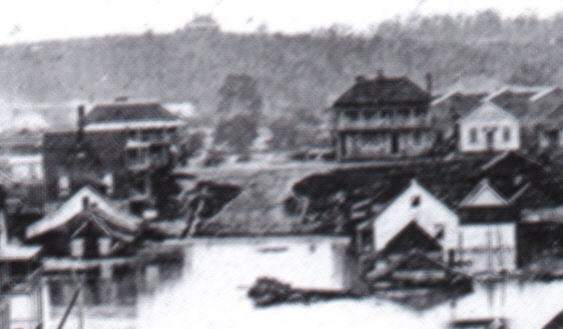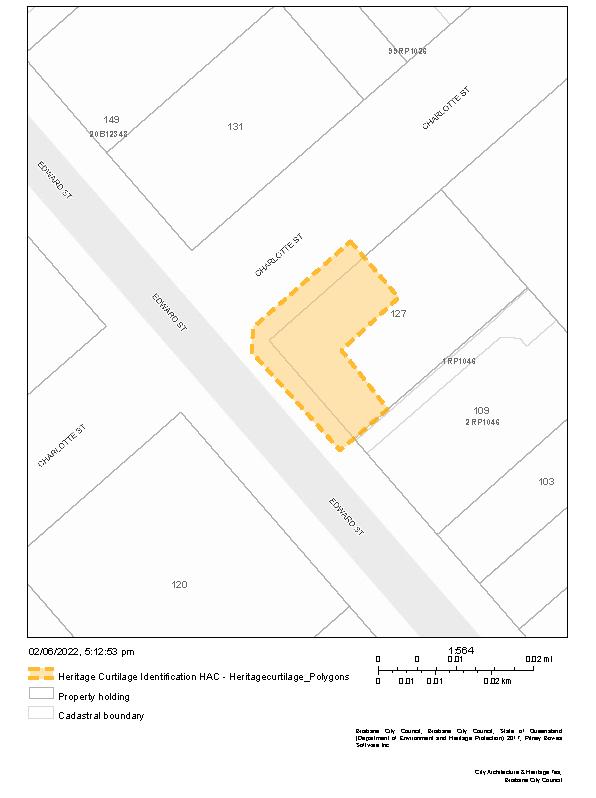Addresses
Type of place
Hotel (pub)
Period
Colonial 1842-1860
Addresses
Type of place
Hotel (pub)
Period
Colonial 1842-1860
This hotel, initially known as the 'Prince of Wales' and later renamed 'Victory', was constructed in 1855. It is the oldest surviving hotel in Brisbane's Central Business District (CBD). The hotel has undergone a number of alterations since the 1880s, including the removal of its verandahs, but nonetheless retains the principal characteristics of a nineteenth century hotel, including its prominent corner position.
Also known as
Prince of Wales Hotel
Lot plan
L1_RP191653 (part - as shown in the curtilage map published in this citation)
Key dates
Local Heritage Place Since —
Date of Citation —
Construction
Walls: Brick - PaintedPeople/associations
Crawford and Mann (Architect);Richard Gailey (Architect)
Criterion for listing
(A) Historical; (B) RarityInteractive mapping
Also known as
Prince of Wales Hotel
Lot plan
L1_RP191653 (part - as shown in the curtilage map published in this citation)
Key dates
Local Heritage Place Since —
Date of Citation —
Construction
Walls: Brick - PaintedPeople/associations
Crawford and Mann (Architect);Richard Gailey (Architect)
Criterion for listing
(A) Historical; (B) RarityInteractive mapping
History
This hotel was erected in 1855 and was initially known as the Prince of Wales. In August 1855, Michael Costello made an application for a publicans licence for the Prince of Wales Hotel. The licence was granted on 4 September 1855. In the first advertisement for the hotel, placed in the Moreton Bay Courier, Costello stated that he had a:
...large and conveniently arranged house, for the accommodation of Boarders, Families, and others [...] No trouble or expense has been spared to make this house comfortable and convenient to all. It shall be second to none in the colony in regard to every thing appertaining to a Hotel.1
Based on the 1862 photographic panorama of Brisbane (see part thereof, above) it would appear that the hotel erected in 1855 forms the basis of the existing building. Like most hotels in Brisbane, the Prince of Wales was constructed on a street corner. This ensured the hotel would become a familiar landmark by which the intersection might be easily identified.
The advertising for the hotel, like most hotels in Brisbane, drew particular attention to its accommodation facilities. This reflected the primary purpose of hotels in Brisbane during the nineteenth century. According to Morrison, writing in the 1880s:
Few cities afford such a variety of hostelry accommodation as the City of Brisbane. The shifting character of the population, and the enormous opportunities for speculation have created a large demand for temporary homes.1
Hotels thus played an intrinsic role in the development of Brisbane, particularly given the significance of land speculation in the City's history. The Prince of Wales Hotel provided a crucial service for travellers to the emergent town at a time when accommodation was not always readily available.
The Prince of Wales Hotel was located in 'Frogs Hollow', an area bounded by Alice, George, Elizabeth and Edward Streets. For much of the nineteenth century, this section of the city was known by this name because it was a low-lying, marshy area prone to flooding. In this period, the area was filled with residential properties, boarding houses, various small businesses and the odd warehouse or factory. All of these were adjacent to the city's increasingly busy wharves, a ferry terminal and the Botanic Gardens. It was a place that teemed with life both day and night and ensured a strong trade for local hotels, along with the need for accommodation.
A number of additions and alterations were carried out on the Prince of Wales Hotel during the 1880s. Architect Richard Gailey designed additions to the hotel in 1882. Gailey was one of Brisbane's most prolific and well-known architects, referred to as "the doyen of Brisbane architects".1 Gailey immigrated to Brisbane from Londonderry in 1864 and in the following year established himself as a practicing architect in the fledgling town. In particular, he was noted for his design of hotels, "which became his specialty".1
Gailey was also responsible for further additions to the Hotel's accommodation facilities in November 1887. Architects E. J. F. Crawford and G. V. F. Mann also designed alterations and additions to the hotel in 1889. The precise nature of these additions and alterations remains unclear. Indeed, this work took place during a significant economic and building boom, which occurred throughout Brisbane during most of the 1880s. During this period a large number of Brisbane hotels were built, extended and redeveloped, no doubt to accommodate the dramatic increase of Brisbane's population, which almost trebled during the decade. The importance of the Prince of Wales Hotel during this period of Brisbane's expansion was noted in the Brisbane Courier.
Additions are being made to two of the oldest hotels in Brisbane — the Metropolitan and the Prince of Wales — which will largely increase the accommodation for travellers and visitors to the city.1
The location of the Prince of Wales in Frogs Hollow also illustrates the other primary purpose of hotels in Brisbane's history, that is, as places for social gatherings. According to Ronald Lawson, by the 1890s Brisbane's hotels also functioned as working men's clubs: "the vast majority of hotel patrons were workingmen: there was a strong lower-class taint associated with drinking in hotels"1 This was the case in a hotel's 'public bar' as opposed to the 'private bar', which was only available to guests staying in the hotel's accommodation. From the 1880s onward, Frogs Hollow was increasingly filled with warehouses and light industry. The proximity of the hotel to such businesses ensured a strong trade from working men.
In 1921, the hotel's name was changed to the 'Victory Hotel', believed to be in commemoration of the cessation of the hostilities of World War I. In 1926 Low & Co won a tender to remodel the Victory Hotel's bar, to designs by Gailey's son, the architect Richard Gailey Jnr. The alterations were consistent with similar work carried out on many of the CBD's older hotels during the 1920s and 1930s in an effort to modernise them.
Further alterations were carried out to the Victory Hotel in the post-World War Two period. A new lavatory block was approved in 1951, and shop fit-outs were undertaken m 1956. When the Victory Hotel was sold in 1957 it was described as a twenty-three-room building. The new owners modernised the building and provided an extra lounge, beer garden, and a laundry. The upper floor verandahs, a distinctive and important architectural feature of nineteenth century hotels, were removed some time after 1957.
Architect John Dimitriou was responsible for renovations of the beer garden area in 1986. Cosmetic refurbishment of existing bars led to the introduction of themed bars, named Nelson's and Trafalgar. The existing awning was added in 1995. Further changes were made to the beer garden area in 2000.
The pressure of commercial development on CBD corner sites, the change in drinking habits caused by the state government's drink driving campaigns and the spread of off-licence beer, wine and spirits shops throughout Brisbane's suburbs have all contributed to the demise of hotels in the CBD. Of the thirty-two hotel sites identified within the central business district in 1951, only seven, including the Victory Hotel, remain. The Victory Hotel no longer provides accommodation as it did during the nineteenth and early twentieth centuries. It does, however, remain a popular inner-city pub, particularly with younger patrons, thus contributing to the hotel's survival.
J. M. Freeland has argued that 'The pub is one of the most socially significant, historically valued, architecturally interesting and colourful features of Australian Society [it] has never been a mere transplant and adaptation of an English progenitor'1 The Victory Hotel provides evidence of these attributes. It is also the oldest remaining hotel in the CBD. The Victory Hotel thus represents an important visual reminder of the prominence of the hotel in the history of Brisbane and, in particular, the CBD.
Description
This is a very early hotel in a prominent corner in the heart of the city. It relates physically and historically to the Exchange Hotel a similar structure on one of the opposite corners. Ongoing changes and refurbishments are characteristic of most hotels as their use evolves with the trends of the times. This early two-storey corner hotel originally built in a colonial vernacular style is no exception.
The hotel has had additions and alterations in 1882 and after November 1887 by architect Richard Gailey and by architects Crawford and Mann in 1889.
In 1926, Low & Co won the tender to fit out the Victory Hotel's bar, to designs by Richard Gailey jnr. A new lavatory block and shop fit-outs were later undertaken and in 1957 the hotel was described as a 23-room building. At this time it was 'modernised' with an extra lounge, beer garden, and a laundry.
The upper floor verandahs, a distinctive and important architectural feature of nineteenth century hotels, were removed post-1957. At the same time the parapet was probably added and chimneys removed while the existing awning was added in 1995.
Notwithstanding the ongoing renovations, the hotel maintains its integrity in its external walls and general form as some of the remaining original elements.
The Local heritage place curtilage (i.e., that part of Lot 1 on RP1919653 as shown in the curtilage map published in this citation) captures the significant or original elements of the place as well as later fabric and elements that are not significant or original to the place
Statement of significance
Relevant assessment criteria
This is a place of local heritage significance and meets one or more of the local heritage criteria under the Heritage planning scheme policy of the Brisbane City Plan 2014. It is significant because:
Supporting images
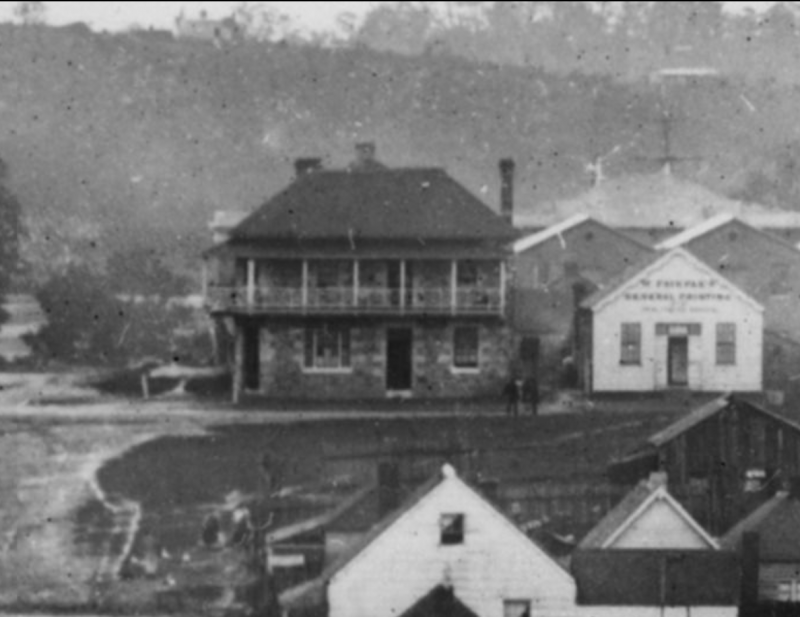
Photographer unknown,
Detail view of the image 'Charlotte Street, Brisbane, during the 1864 flood',
showing the Prince of Wales Hotel (current Victory Hotel),
John Oxley Library, State Library of Queensland
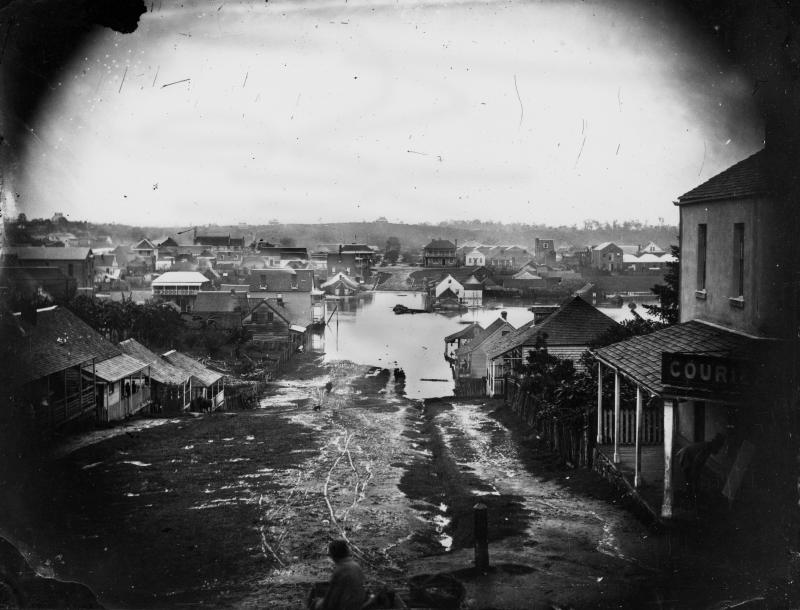
Photographer unknown,
'Charlotte Street, Brisbane, during the 1864 flood',
John Oxley Library, State Library of Queensland
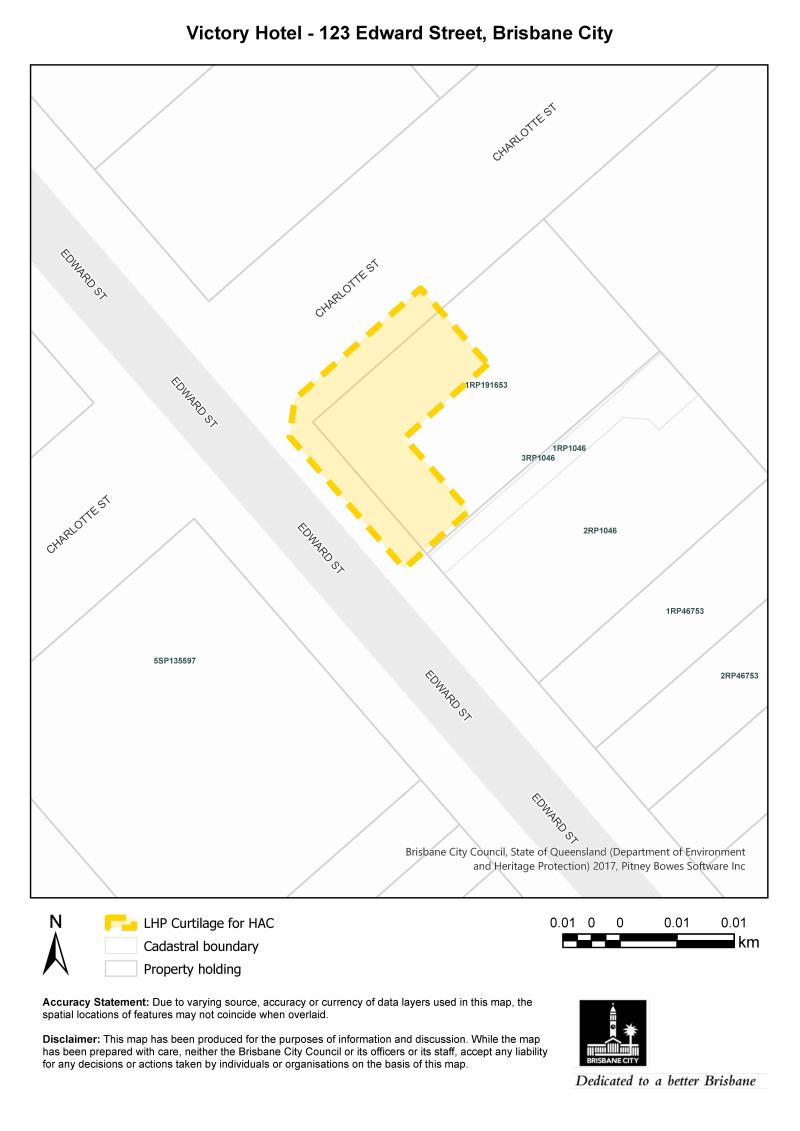
This is an image identifying the curtilage of the Local heritage place known as Victory Hotel, 127 Edward Street, Brisbane City.
References
-
Moreton Bay Courier, 13 October 1855, n.p.
-
Brisbane History Group, Brisbane By 1888: The Public Image, Brisbane, Brisbane History Group, 1987, p. 198
-
Donald Watson, & Judith McKay. Queensland Architects of the 19th Century: A Biographical Dictionary. (Brisbane. Queensland Museum. 1994). p 72
-
Ibid
-
Brisbane Courier
-
Ronald Lawson, Brisbane in the 1890s: a study of an Australian urban society, Brisbane, University of Queensland Press, 1987, p.236.
-
J. M. Freeland, The Australian Pub, Melbourne, Sun Books, 1977, p. 1
-
Nundah & Districts Historical Society Newsletter No. 80, December 2009, p. 10
-
Brisbane City Council, Properties on the Web, post-1946 building approval cards
-
Brisbane City Council, 1946 aerial photographs.
-
Brisbane City Council, Sewerage Map, 1913
-
Brisbane History Group, Brisbane By 1888: The Public Image, Brisbane, Brisbane History Group, 1987
-
Brisbane Courier, 1877
-
Department of Natural Resources, Queensland Certificates of title and other records.
-
Donnelly, J.J. Hotels of Brisbane, B. Arch thesis, University of Queensland, 1967
-
Freeland, J. M., The Australian Pub, Melbourne, Sun Books, 1977
-
G. Greenwood and J. Laverty. Brisbane 1859-1959: A History of Local Government. Brisbane: BCC, 1959.
-
John Oxley Library, photographic collection.
-
John Oxley Library, newspaper clippings files
-
R. Lawson Brisbane in the 1890s Brisbane:University of Queensland Press, 1987
-
Mahlstedt & Son, City of Brisbane Detail Fire Survey, Map No. 11,1951
-
Moreton Bay Courier, 1855
-
Queensland Post Office Directories, 1868-1949
-
Donald Watson and Judith McKay, Queensland Architects of the Nineteenth Century, South Brisbane: Queensland Museum, 1994
Citation prepared by — Brisbane City Council (page revised August 2023)


